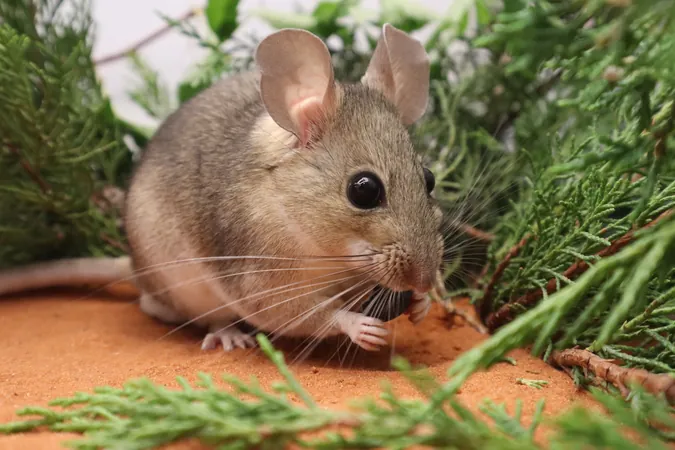
Revolutionary Study Reveals Woodrats' Secret to Surviving Toxic Plants
2025-09-15
Author: Mei
Eating green isn’t as easy as it seems! Most plants come armed with toxic chemicals designed to keep herbivores at bay, creating a never-ending challenge for animals trying to stay nourished while avoiding potentially deadly poisons.
Enter the woodrat—a remarkable creature that thrives on these hazardous plants. According to Utah State University ecologist Sara Weinstein, understanding their unique feeding habits could unlock vital information about survival strategies in changing environments.
Woodrats, belonging to the genus Neotoma, have made a name for themselves as unexpected models for dietary studies. Native to North America, these shy, herbivorous rodents don’t just nibble on conventional greens—they can chow down on notoriously toxic plants like creosote bush and mesquite, packed with alkaloids and terpenes.
An Extensive Eight-Year Study: Uncovering Secrets of Woodrat Diets
Weinstein, alongside researchers from the University of Utah and other prestigious institutions, conducted a monumental eight-year survey of woodrat populations across North America. Their findings, published in the "Proceedings of the National Academy of Sciences," showcase woodrats as phenomenal organisms for studying dietary decision-making.
Unlike the notorious city-dwelling rats, these elusive woodrats prefer to keep their distance from humans. As Weinstein puts it, "They’re distant cousins to the famous New York pizza rat, and you’re unlikely to catch a glimpse of them unless you’re in a relatively untouched habitat. However, their widespread presence and diverse species groups make them ideal subjects for dietary versus individual population studies!"
Balancing Act: The Strategy Behind Woodrat Food Choices
Observing woodrats in their natural habitat offers crucial insights into how these animals navigate their diets. With their small size, they are also much easier to manage for research purposes, allowing scientists to collect data effortlessly—especially since woodrats tend to leave behind a wealth of droppings in their traps!
Each droppings sample provides a snapshot of a woodrat's daily food choices, revealing fascinating dietary patterns.
The Powerful Impact of DNA Metabarcoding
Thanks to groundbreaking advancements in DNA metabarcoding and next-generation sequencing, researchers now have extraordinary tools at their disposal to analyze animal diets. Weinstein highlights how these methods are revolutionizing our understanding of species' resilience, particularly in mammalian herbivores.
Despite this, a significant knowledge gap remains regarding diet breadth. Past theories suggested that extreme dietary specialization could jeopardize survival if key food sources disappear due to shifting ecosystems or invasive species.
Conversely, being a generalist—able to adapt to various food sources—could enhance survival prospects.
Generalists: Not Just Jack-of-All-Trades
While many woodrat populations are categorized as generalists, Weinstein's research indicates that individuals might not have as broad a diet as previously thought. She argues, "Instead of being mere jacks-of-all-trades, it appears that most generalists are actually jacks-of-all-trades, masters of some, selecting a consistent subset of plants to manage the risks associated with toxic food consumption."
Implications for Ecosystems and Food Webs
These dietary constraints on woodrats carry significant implications for understanding complex food webs, species interactions, and which populations are most likely to endure in the face of ecological changes. As our planet evolves, lessons from these mighty little foragers could help reveal the key to survival amidst toxicity.


 Brasil (PT)
Brasil (PT)
 Canada (EN)
Canada (EN)
 Chile (ES)
Chile (ES)
 Česko (CS)
Česko (CS)
 대한민국 (KO)
대한민국 (KO)
 España (ES)
España (ES)
 France (FR)
France (FR)
 Hong Kong (EN)
Hong Kong (EN)
 Italia (IT)
Italia (IT)
 日本 (JA)
日本 (JA)
 Magyarország (HU)
Magyarország (HU)
 Norge (NO)
Norge (NO)
 Polska (PL)
Polska (PL)
 Schweiz (DE)
Schweiz (DE)
 Singapore (EN)
Singapore (EN)
 Sverige (SV)
Sverige (SV)
 Suomi (FI)
Suomi (FI)
 Türkiye (TR)
Türkiye (TR)
 الإمارات العربية المتحدة (AR)
الإمارات العربية المتحدة (AR)